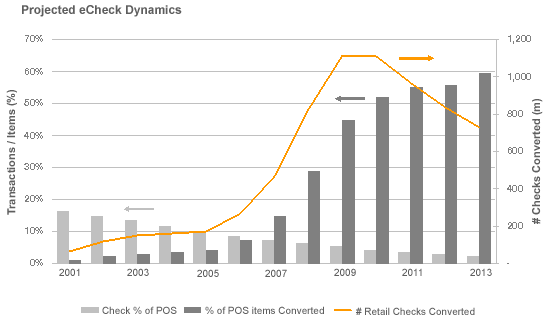Back Office Conversion: Too Little Too Late?
Abstract
NACHA's introduction of back office conversion (BOC) in March 2007 was met with surprising interest among retailers, even as checks declined at point of sale. BOC's introduction, however, was too late to produce meaningful volume for the ACH network.
Many declared back office conversion dead on arrival upon its introduction last March. After all, POP check conversion, launched in 1999, languished for years, and published NACHA BOC statistics through the third quarter are disappointing. In the end, 2007 and 2008 will be met with a significant number of check conversion implementations (both BOC and POP) among retailers of all sizes. BOC will be too little, too late, however, to produce significant ACH transaction volume, as a result of growing eCheck retail adoption offset by rapidly declining check usage at point of sale.
A new report from Celent, ?, includes results of a survey of more than 300 retail treasury staff conducted by Celent in July 2007. The survey revealed surprising interest in retail check conversion, given POP's seven-year history of lackluster transaction volume. Among the survey's findings were:
- Awareness of BOC solutions has risen to 45% of surveyed retailers through July 2007, just four months since its launch. This compares to 75% awareness of POP after seven years.
- 67% of retail treasury staff surveyed who were aware of BOC expressed interest in it, compared to 60% for POP.
- 6% of retailers report evaluating the business case for retail check conversion, and virtually all are doing so comprehensively, evaluating all eCheck options.
"A strange irony of BOC's unveiling is that its launch has spawned a resurgence of POP interest. Early opposition to POP was due in part to its 'consumer as keeper' design, leading to fear of consumer confusion and slower checkout. However, in the seven years since POP's launch, the consumer fear factor has all but disappeared," says Bob Meara, senior analyst and author of the report.
Roughly 60% of retailers employ check verification and guarantee services. These merchants already capture check code lines at point of sale as part of the verification process. Therefore, no further hardware investment is required for retailers considering POP. In those cases, the modest per store investment in a single scanner for BOC may seem imprudent when POP could be used cheaply.
Celent's projections include:
- Beginning in 2007, a growing percentage of retail checks presented for payment will be converted to ACH, approaching 60% of items presented by 2010.
- Check usage at point of sale will continue to decline, reaching just 4% of POS transactions in 2010. Consequently, the items available for conversion will continue to dry up.
- Converted retail checks will grow rapidly through 2009 to approximately 1 billion items annually, spawned by growing adoption of both BOC and POP applications. Volumes will fall, however, beginning in 2010, driven by declining check usage at point of sale.
- POP, which benefits from a seven-year head start on BOC, will maintain its lead. The profound influence of "the Wal-Mart effect," coupled with First Data's obvious dominance, will impact its success. By 2010, POP will account for three-quarters of retail eCheck volume.

The 38-page report contains 23 figures and six tables. A table of contents is available online.
Members of Celent's Wholesale Banking research service can download the report electronically by clicking on the icon to the left. Non-members should contact info@celent.com for more information.

